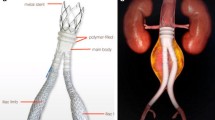Abstract
The purpose of this study was to examine the immediate and midterm outcomes of percutaneous endovascular repair of thoracic and abdominal aortic pathology. Between December 2003 and June 2005, 21 patients (mean age: 60.4 ± 17.1 years; 15 males, 6 females) underwent endovascular stent-graft insertion for thoracic (n = 13) or abdominal aortic (n = 8) pathology. Preprocedural computed tomographic angiography (CTA) was performed to assess the suitability of aorto-iliac and common femoral artery (CFA) anatomy, including the degree of CFA calcification, for total percutaneous aortic stent-graft repair. Percutaneous access was used for the introduction of 18- to 26-Fr delivery devices. A ‘preclose’ closure technique using two Perclose suture devices (Perclose A-T; Abbott Vascular) was used in all cases. Data were prospectively collected. Each CFA puncture site was assessed via clinical examination and CTA at 1, 6, and 12 months, followed by annual review thereafter. Minimum follow-up was 36 months. Outcome measures evaluated were rates of technical success, conversion to open surgical repair, complications, and late incidence of arterial stenosis at the site of Perclose suture deployment. A total of 58 Perclose devices were used to close 29 femoral arteriotomies. Outer diameters of stent-graft delivery devices used were 18 Fr (n = 5), 20 Fr (n = 3), 22 Fr (n = 4), 24 Fr (n = 15), and 26 Fr (n = 2). Percutaneous closure was successful in 96.6% (28/29) of arteriotomies. Conversion to surgical repair was required at one access site (3.4%). Mean follow-up was 50 ± 8 months. No late complications were observed. By CT criteria, no patient developed a >50% reduction in CFA caliber at the site of Perclose deployment during the study period. In conclusion, percutaneous aortic stent-graft insertion can be safely performed, with a low risk of both immediate and midterm access-related complications.
Similar content being viewed by others
References
Hinchliffe RJ, Ivancev K (2008) Endovascular aneurysm repair: current and future status. CardioVasc Interv Radiol 31:451–459
Morasch MD, Kibbe MR, Evans ME et al (2004) Percutaneous repair of abdominal aortic aneurysm. J Vasc Surg 40:12–16
Quinn SF, Kim J (2004) Percutaneous femoral closure following stent-graft placement: use of the perclose device. CardioVasc Interv Radiol 27:231–236
Haas PC, Kracjer Z, Dietrich EB (1999) Closure of large percutaneous access sites using the Prostar XL percutaneous vascular surgery device. J Endovasc Surg 6:168–170
Lee WA, Brown MP, Nelson PR et al (2007) Total percutaneous access for endovascular aortic aneurysm repair (‘Preclose’ technique). J Vasc Surg 45(6):1095–1101
Traul DK, Clair DG, Gray B et al (2000) Percutaneous endovascular repair of infrarenal abdominal aortic aneurysm: a feasibility study. J Vasc Surg 32:770–776
Torsello GB, Kasprzak B, Klenk E et al (2003) Endovascular suture versus cutdown for endovascular aneurysm repair: a prospective randomized pilot study. J Vasc Surg 38:78–82
Howell M, Villareal R, Krajcer Z (2001) Percutaneous access and closure of femoral artery access sites associated with endoluminal repair of abdominal aortic aneurysms. J Endovasc Ther 8:68–74
Lee WA, Brown MP, Nelson PR et al (2008) Midterm outcomes of femoral arteries after percutaneous endovascular repair using the Preclose technique. J Vasc Surg 47(6):919–923
Teh LG, Sieunnarine K, van Schie G et al (2001) Use of the percutaneous vascular surgery device for closure of femoral access sites during endovascular aneurysm repair: lessons from our experience. Eur J Vasc Endovasc Surg 22:418–423
Borner G, Ivancev K, Sonesson B et al (2004) Percutaneous AAA repair: I it safe? J Endovasc Ther 11:621–626
Dosluoglu HH, Cherr GS, Harris LM et al (2007) Total percutaneous endovascular repair of abdominal aortic aneurysms using Perclose ProGlide closure devices. J Endovasc Ther 14:184–188
Jean-Baptiste E, Hassen-Khodja R, Haudebourg P et al (2008) Percutaneous closure devices for endovascular repair of infra-renal abdominal aortic aneurysms: a prospective, non-randomized comparative study. Eur J Vasc Endovasc Surg 35:422–428
Kennedy PT, Collins A, Blair PH et al (2003) Suture-mediated vascular closure devices for large arteriotomies. Br J Surg 90:508
Hogg ME, Kibbe MR (2006) Percutaneous thoracic and abdominal aortic aneurysm repair: techniques and outcomes. Vascular 14:270–281
Watelet J, Gallot JC, Thomas P et al (2006) Percutaneous repair of aortic aneurysms: a prospective study of suture-mediated closure devices. Eur J Vasc Endovasc Surg 32:261–265
Shim CY, Park S, Ko YG et al (2008) Percutaneous closure of femoral artery access sites in endovascular stent-graft treatment of aortic disease. Int J Cardiol 130(2):251–254
Starnes BW, Anderson CA, Ronsivalle JA et al (2006) Totally percutaneous aortic aneurysm repair:experience and prudence. J Vasc Surg 43(2):270–276
Nasu K, Tsuchikane E, Sumitsuji S, PARADISE Investigators (2003) Clinical effectiveness of the Prostar XL suture-mediated percutaneous vascular closure device following PCI: results of the Perclose AcceleRated Ambulation and DISchargE (PARADISE) trial. J Invas Cardiol 15:251–256
Noguchi T, Miyzaki S, Yasuda S et al (2000) A randomised controlled trial of Prostar Plus for haemostasis in patients after coronary angioplasty. Eur J Vasc Endovasc Surg 19:451–455
Kent KC, McArdle CR, Kennedy B et al (1993) A prospective study of the clinical outcome of femoral pseudoaneurysm and arteriovenous fistulas induced by arterial puncture. J Vasc Surg 17:125–133
Brown DB, Crawford ST, Norton PL et al (2002) Angiographic follow-up after suture-mediated femoral artery closure. J Vasc Interv Radiol 13:677–680
Author information
Authors and Affiliations
Corresponding author
Rights and permissions
About this article
Cite this article
Bent, C.L., Fotiadis, N., Renfrew, I. et al. Total Percutaneous Aortic Repair: Midterm Outcomes. Cardiovasc Intervent Radiol 32, 449–454 (2009). https://doi.org/10.1007/s00270-009-9537-3
Received:
Revised:
Accepted:
Published:
Issue Date:
DOI: https://doi.org/10.1007/s00270-009-9537-3




